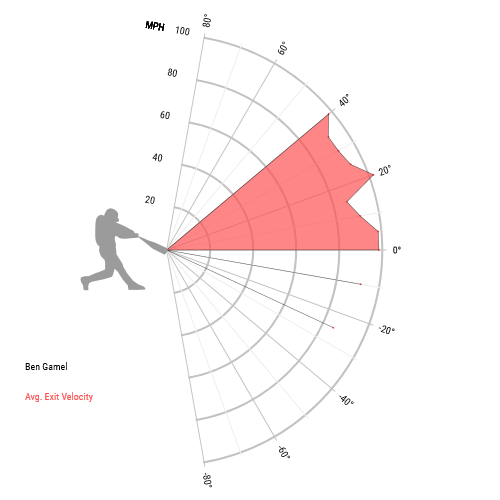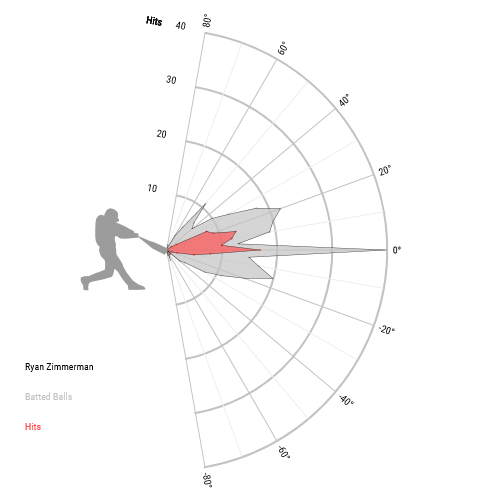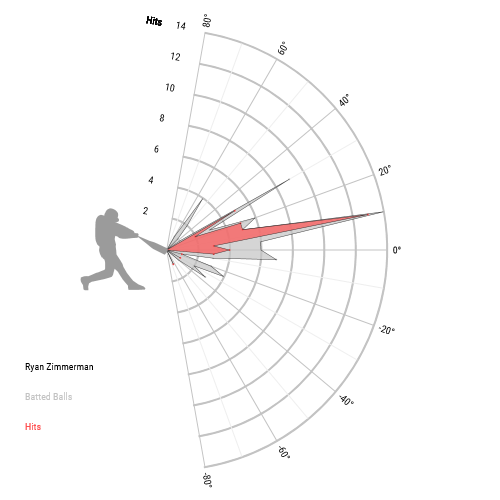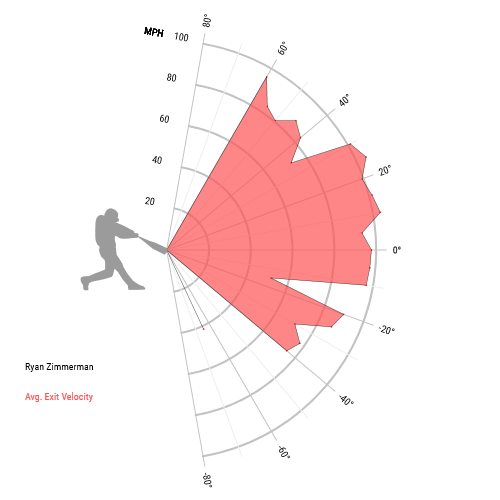Ben Gamel, Another Fly Ball Revolutionary
After yesterday’s game, Ben Gamel’s slash line is up to .363/.475/.588. A hitter I thought might wash out due to an overly passive approach combined with remarkably little power for his position has turned into a dominant hitter. Will this last? No, not THIS level, but he’s done enough to show that he’s fundamentally different from the hitter we saw last year, and, from the looks of things, different from the guy who came up in the Yankees system.
This is a familiar refrain this year. I mentioned Taylor Motter’s transformation in April, and while the guy still can’t quite get regular playing time, he’s still been a solid hitter. Jean Segura’s metamorphosis happened last year in Arizona, and Mitch Haniger’s happened in Arizona’s minor league system.
Looking out beyond our local team, the talk of baseball has been the remarkable starts for Yonder Alonso and Ryan Zimmerman, two 1Bs who put up atrocious lines last year, and seemed like candidates for DFAs (Alonso) or cautionary tales about contract extensions (Zimmerman) instead of All Star/MVP votes. All of these sudden changes affect more than the player’s batting average of course. With Statcast data, we can now document that a change in swing path has occurred, or added batted ball speed, or see the effects in ground ball rate and the like. Alonso and Zimmerman have been the poster boys for the fly ball revolution, or adding loft to their swings and going from under-powered disappointments to home run mashing monsters. This stuff is everywhere; I was watching a Dodgers game the other day, and the broadcast was talking about Chris Taylor trying to elevate the ball more. I mentioned it with Cesar Hernandez, and Ryan Schimpf in San Diego’s another light-weight example. It’s not just for hulking 1Bs.
Ben Gamel’s doing much the same thing here in Seattle, and while he’s not producing tons of home runs, the changes in his swing are generating positive returns in other ways. But the more you look at Gamel and Motter (or the more you look at Alonso and Zimmerman for that matter) the more you see the differences in their changes. Yes, many players have manifestly different outcomes this year, and yes, those results seem to be the product of altered swings and approaches to at-bats, but there are many roads to excellent statcast numbers. In this post, I wanted to highlight what Gamel’s doing, and how different it is to what Motter was and is doing, and highlight how subtle some of these adjustments are. Then, I want to talk a bit about why we don’t see a lot more league-wide evidence of a “revolution” when more and more players are changing their swing paths, and more and more teams are preaching the gospel of fly balls.
A year ago, the average batted ball came off the bat at an angle of 10.8 degrees and at a speed of 87.6 MPH. That angle’s actually pretty good, as, according to MLB’s Tom Tango, batters maximize their expected batting average at around 12 degrees (you won’t hit HRs at that angle, but you can get plenty of base hits). Batters with average launch angles lower than average are, in general, going to hit a lot of grounders and not much power. Those with angles above the average *could* hit for power, but only if they hit the ball hard enough. This is intuitive, but important: a low average exit speed combined with a higher launch angle – even if that higher launch angle is often seen as ideal for others – is a terrible combination. Each batter can try and alter one or both variables – angle and speed.
As we discussed earlier, Motter’s launch angle hasn’t changed all that much from 2016. It was 11.6 last year, and it’s 15 degrees now. His 2016 average was higher than our other “fly ball revolutionaries” (Gamel, Alonso, Zimmerman), but he was still awful because he combined that angle with well below average exit velocity. He elevated weakly hit balls, and that’s a recipe for disaster. Statcast now has an “Expected wOBA” measure using angle/speed, and by that metric, Motter deserved his crappy 2016 line; given his balls in play, we would expect them to produce a wOBA of .282, pretty close to his actual line of .267. Gamel was even worse. His average launch angle was just 3.7 degrees, less than half of Ryan Zimmerman’s 2016 rate, and a third of Motter’s. He hit the ball about as hard as Motter – his average was just a fraction higher than his future teammate’s. Add those to ingredients together, and Gamel’s expected wOBA was .270, which, for a corner OF, is about 2 steps below replacement level.
This season, Motter’s hitting the ball much, much harder. In our group of four, his year over year increase in batted ball speed dwarfs the rest. This focus on power has produced a big change in the percentage of the balls he pulls. In fact, Motter leads all of MLB in pull percentage. He’s lost some ground balls in the process, but he’s also avoiding infield fly balls.
Gamel’s increased his batted ball speed too, to around 90 MPH, or above the league average. It’s not up with Motter or Ryan Zimmerman, but it’s playable. The big change with Gamel is his launch angle, which went from 3.7 to 11.8 degrees. Now, what used to be ground balls are turning into line drives. He’s shaved 15 percentage points off of his ground ball rate, and he’s yet to hit an infield pop-up, meaning those grounders are now LDs and fly balls. Here’s a visualization of his batted balls via Statcast.
 Essentially everything he hits is between 0 and 40 degrees, with maximum velocity at around 20 degrees. That’s a recipe for gap power, and it’s pushed Gamel’s xwOBA to .415, close-ish to his off-the-charts actual wOBA of .457. Gamel’s the guy who’s actually altered his swing path. Motter left his essentially unchanged, but is selling out for power, looking for balls to turn on and then swinging like hell at them. Gamel’s using more of the field, but avoiding mis-angled hits like the plague.
Essentially everything he hits is between 0 and 40 degrees, with maximum velocity at around 20 degrees. That’s a recipe for gap power, and it’s pushed Gamel’s xwOBA to .415, close-ish to his off-the-charts actual wOBA of .457. Gamel’s the guy who’s actually altered his swing path. Motter left his essentially unchanged, but is selling out for power, looking for balls to turn on and then swinging like hell at them. Gamel’s using more of the field, but avoiding mis-angled hits like the plague.
Gamel’s closer to what Yonder Alonso’s done. Alonso had a launch angle of around 10 degrees last year, a touch below average (and Motter), and an average exit speed right around league average (a touch above). This year, he’s *doubled* his average launch angle. It’s now 21.6 degrees, by far the highest of our group. He and Gamel have very similar exit velocities now, and both trail Motter/Zimmerman by a few ticks. His batted ball profile is totally different now, with a shift of about *20 percentage points* moving from the ground ball column over into fly balls. This is how a guy who hit 12 HRs across *934 PAs* from 2015-2016 now has 11 HRs in 113 2017 PAs.
So if Gamel’s a subtler, more line-drivey, version of Alonso’s changes, are there similarities between Motter and Zimmerman? No. As you’ve probably heard, Zimmerman already hit the ball hard – far above average in 2016, and far, far ahead of anyone else in our group. His average launch angle wasn’t great, at just 9 degrees, but it wasn’t *that* different from Alonso’s or Motter’s. He was unlucky to be sure, but he wasn’t going to be great with that combination of angle/speed.
One thing that’s kind of interesting about Zimmerman is the distribution of his batted balls. Last year, his modal batted ball was right around 0, hence his nearly 50% ground ball rate. He hit a few fly balls, and hit a few chopped grounders, but the distribution looks tighter than it does for most hitters:

This year, Zimmerman’s launch angle has moved from 9 degrees waaaay up to…11 degrees. As far as revolutionary changes go, this leaves a little to be desired. Our poster boy for the fly ball revolution has the lowest average launch angle in the group. Luckily for him, changes don’t need to be sweeping to produce sweeping effects. He’s still got that tightly-bunched distribution of batted balls, but instead of centering below the average, it’s right on it. He’s hitting ton of balls at ~ 10 degrees:

Even better, his *best* contact, the balls hit the hardest, have been those hit between about 15-25 degrees. That’s why he’s slugging .820 at the moment.

Zimmerman’s seemingly subtle changes have transformed him. Gamel’s changes have taken him from someone I considered a lost cause to an eye-opening story. Especially at this point in the year, I’m sympathetic to charges that this is all small sample noise. Gamel doesn’t have much of a big league track record, after all. But over the course of several MiLB seasons, he’d shown he was a reliably under-powered hitter, with ISOs under .100 in a couple of full seasons, and ground ball rates from 45-50%. Even in a small sample, what he’s showing this year is radically different. He may not be able to keep up this pace, but he’s shown that just applying an MLE to his minor league numbers isn’t going to work.
So we’ve seen a number of different hitters tweak a couple of different variables. They’ve changed their batted ball profiles and become much, much better hitters, but they’ve taken different paths. There may BE a wrong way to go about this, but there are clearly several right ways. Teams see this, and players see this (Zimmerman may have talked to teammate Daniel Murphy for some advice in his swing path), and players from Josh Donaldson to Murphy have gone from average or fringe big leaguers to highly paid superstars. So is the league as a whole hitting more fly balls and fewer grounders? No, it’s not.
The league-wide GB% is 44.5% this year. It was 44.3% in 2010, and 44.7% last year. There’s simply no evidence of a clear and obvious shift here. Why not? This reminds me a bit of the talk around infield shifts the past few years. At first it was just the Rays, but then more and more teams started doing it, and league-wide shifts soared, doubling or tripling several years in a row. And league-wide BABIPs…didn’t budge. As revolutions go, the fly ball revolution – like ShiftMania – has been remarkably quiet.
I have no idea, really, but I’ll put up a hypotheses. My idea is that we have two large-scale trends that may be counteracting each other. The past several years have seen more and more low pitches thrown, as the strike zone expanded downward. This year, 54.9% of pitches are in the bottom third of the zone or below. Last year, it was 51.3%,* and in 2015, 51.2%. Back in 2012? Just 48%. Pitch height and ground balls are correlated; throwing a pitch lower makes it more likely to be hit on the ground. This study by Gerald Schifman goes into a lot of detail, but for now, the point is that with more and more low pitches (and more and more non-fastballs), we should be seeing a spike in ground balls. As we just saw, we’re not. Pitchers are doing everything they can to generate MORE grounders, while batters seem to be tweaking their swing plane to add loft**, and the two seem to be almost exactly canceling each other out. For every Zimmerman, a Keuchel; for every Gamel, a Stroman.
What do you think? Will we eventually see an uptick in fly balls, especially now that the strike zone isn’t growing any more (and may be shrinking)?
* I know pitch velocity measurement changed between 2016 and 2017, as MLB shifted from pitch fx to statcast, but I don’t know if these location data also changed. I don’t think so, but if they did, then this may not be as dramatic a shift.
** Remember, the big increase in HRs league wide isn’t coming on high pitches…it’s happening on low pitches.
Comments
6 Responses to “Ben Gamel, Another Fly Ball Revolutionary”
Leave a Reply
You must be logged in to post a comment.

This is really good analysis, Mark.
Back in the day, the coach would simply say: “Get the barrel to the ball and get some backspin on it. Get a little bit of ass into it, too!”
Now – its far more complex sounding.
You will probably hear Mike Blowers say “barrel it up” or “he got the barrel to it” – 4 or 5 times per broadcast. What I think he means when he says this is everything you wrote about above, as well as what someone would have said “back in the day.”
Very good write-up.
Ted Williams used to insist (absolutely insist) that all batters should swing with a slight uppercut. He insisted on this in the 1940’s.
The 1940’s!
This stuff isn’t new. It’s also not easy to do. The swing path takes a bat from high to ball level and the hitter finishes “high.” There is always going to be a loop in the swing, regardless of how “level” one swings.
Late in his life I saw an interview with Ted Williams where he talked about the “arguments” that he used to get in with one of his teammates (Bobby Doerr I think – but I’m not sure) in regard to how important the “launch angle” was. Although I think at the time – the Splendid splinter simply called it an “uppercut.”
This stuff isn’t new and Teddy Ballgame would be really happy to hear that people agree with him. Arguably the best hitter, ever.
The thought process is not new, but the data validation of the thought process might be – since technology allows it to be visualized so easily and so readily. In addition, there might simply be more guys trying it who have the skills to do it.
RIP Ted
For anyone interested in the short version:
Google: Kris Bryant takes lessons from Ted Williams’s batting bible.
The longer version: A book … an actual book from 1971 entitled: The Science of hitting
Fantastic article Marc.
Thank-you.
Always love your good numerical analysis combined with solid writing, that brings the message home for all of us to understand. Thanks a bunch!
This is great. I wish/hope that final plot is what we see when Tyler O’Neill gets to the Mariners, because it looks like a glorious Maple Leaf.